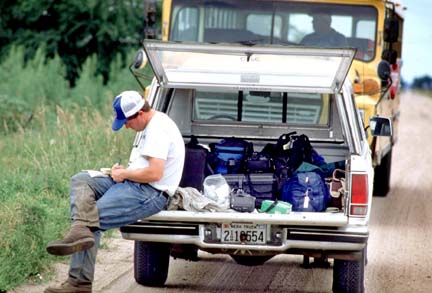
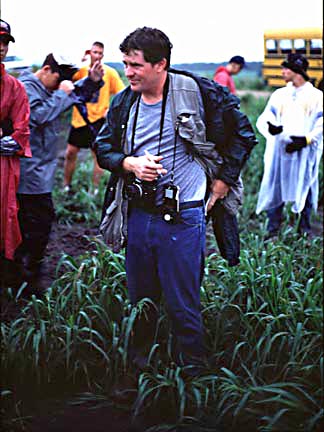
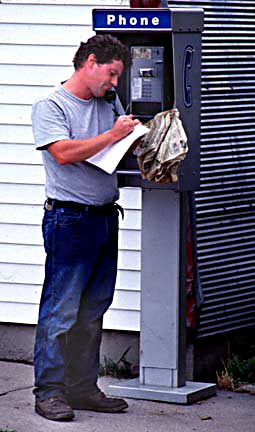
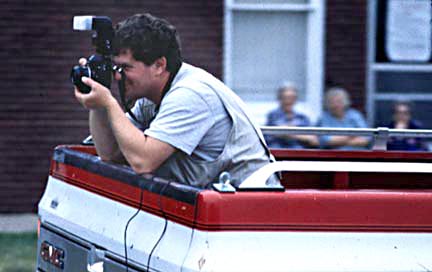
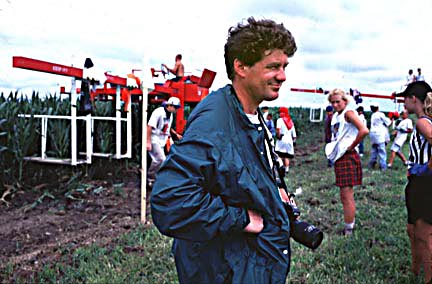
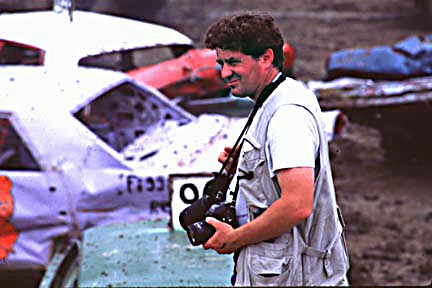
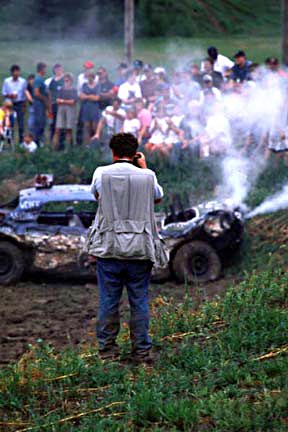
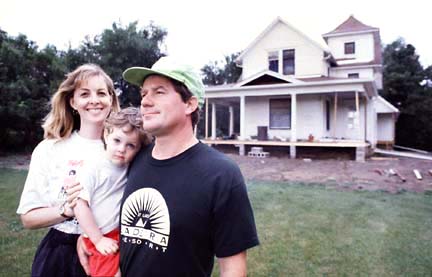
Associate Professor of Journalism
The University of Florida
The hotel phone rings at 4:52 a.m., and Joel Sartore
says he's ready to go. "You up, John? Meet me in the
lobby." I head downstairs and stare out into the
darkness of Lincoln, Neb.
At 5:02 a.m., a white 1989 Chevy pick-up arrives and I
stumble out to greet Sartore, who's guzzling a cold can
of Coke. Driving his dad's former fishing truck, Sartore
is shooting a feature spread on Nebraska for National
Geographic. I'm going to be his assistant for two
days.
During the previous seven weeks, as the recipient of the
photographic division's summer faculty fellowship, I
walked the halls and poked my head into offices at the
magazine's headquarters in Washington, D.C. Now I'm out
in the field to further observe how one of the world's
top magazines gathers its photographs. The fellowship is
a far cry from my regular job overseeing the
photojournalism sequence at the University of Florida.
It's cold and rainy and still dark as we drive toward
Seward, Neb., where a crew of middle schoolers is
detassling corn. Wearing maroon ponchos, they wade
through the mud, breaking off the seed part of the corn
to keep the hybrids pure. By dawn's gray, even light,
Sartore shoots through the rain-drenched stalks of corn.
The students' work is monotonous and tiring and messy,
and Sartore emerges sweaty and disheveled on the far side
of the field. Cracking a wry smile, he tells me:
"I'm going back in." I had already reviewed
some of Sartore's Nebraska project earlier in the summer.
Batches of film are routinely shipped to Washington for
processing. I knew that Sartore would see things in that
wet cornfield that I wouldn't. I knew his viewpoint would
include a touch of quirkiness. But the one thing I didn't
know was that we'd seldom stop, except for three meals a
day at McDonald's (always eaten in the truck).
Geographic photographers are known to shoot
early and late in the day, and sleep during the
afternoon, but our hectic pace continues from sunup until
past sundown. Sartore uses afternoons for travel and
phone calls. He figures 40 percent of his time is spent
researching what's meaningful to shoot. Maps and yellow
notepads with names and numbers clutter the inside of his
truck.
Unlike most freelance magazine photographers, Geographic
shooters construct the story line as they see it from the
field. They receive some guidance from editors, but are
expected to have a thorough sense of an area's history,
economics and social structure. Typical assignments in
the past used to stretch to six months, but now many are
limited to six weeks. Since Sartore lives in Nebraska,
this project was being shot off and on over a year and
half. "It's still one of my favorite stories,"
Sartore says in retrospect. "It was really nice to
sleep in my own bed for a change. They never had to buy
me plane ticket."
The corn detasslers finish their job by early afternoon
and Sartore wants to ride back in the school bus with the
tired group. I follow along through a rainstorm in the
white pick-up, wondering what adventure is next.
We head for Western, a tiny town with a four-way stop in
the heart of downtown. Sartore wants to check out a
scenic life-size 1909 mural, hoping to photograph
pedestrians who will seem to blend into the painting. A
Founder's Day parade brings lawn chairs out to the curbs
of Main Street, and I lose sight of Sartore. Minutes
later he comes riding by on the back of a homemade float,
photographing a man wearing a Richard Nixon mask.
Sartore shoots the carnival rides and bingo games
throughout the golden light of twilight, then we drive on
to Grand Island. The Holiday Inn seems to be hosting a
high school cheerleading clinic that has spilled into the
hallway outside our rooms. It's 10:20 p.m.
Sartore has located a second group of detasslers using a
type of people mover in the fields, so Day 2 begins near
Chapman (pop. 272) at 6 a.m. The ground is muddy here
too, but the light is bright and strong and the sky is a
brilliant blue. "Hi. I' m Joel from National
Geographic and we're doing a story on
Nebraska," Sartore tells every group before he
starts shooting. The students mug the camera for a few
minutes then forget him. Having moved to Nebraska at age
2, Sartore considers himself a native. His parents and
in-laws live nearby.
By 3 p.m. that Sunday, we're far away from the
detasslers. We arrive in Bloomington for a demolition
derby. It's hot and still, and the bleachers around a
large embankment are full of spectators waiting to see
which car can smash and be smashed and still run at the
end. One of the top prizes is a rifle. The noisy
spectacle reeks of gasoline fumes and burned oil. The
championship round is over by 5 p.m., but Sartore wants
more. We head for a bigger derby in Fairbury. The
grandstand there shades the field and it gets darker as
Sartore shoots until almost 9 p.m. Finally, we head back
to his hometown of Lincoln. I drive part of the way while
he scribbles down caption information and labels 45 rolls
of film for shipment.
Sartore is modest about his work that often results in
prize-winning photographs or book covers such as the
recent One Digital Day. Referring to the
demolition derbies, he says, "Anyone with an 80-200
standing where I was could've shot the same
pictures." He credits both his University of
Nebraska photo professor, George Tuck, and his first
boss, Steve Harper of The Wichita Eagle, for
suggesting he work on projects instead of just hunting
for single features.
On my final morning in Nebraska I invite myself out to
see Sartore's latest personal project: a two-story
Victorian farmhouse sitting on 20 acres of land eight
miles outside Lincoln. He and wife Kathy have plans to
restore it to a home with more than 3,000 square feet and
modern upgrades like heating, cooling and indoor
plumbing. But with a second child now and Sartore gone so
often on assignment, they've decided it's best to move
back into town during fall 1998.
My weekend as an assistant was a bonus, not a guaranteed
part of the fellowship. It did provide valuable insight
into the pressure of shooting for National Geographic,
and reinforced my respect for the long hours and
dedication it takes to succeed.
(Copyright 1998, by John Freeman)
Originally published by the National Press Photographers
Association and
News Photographer magazine, October 1998. To see Joel
Sartore's finished article on Nebraska, see the November
1998 issue of National Geographic magazine.
Special thanks to Tom Kennedy and Kent
Kobertsteen for the fellowship award and their
hospitality during the summer of 1996.